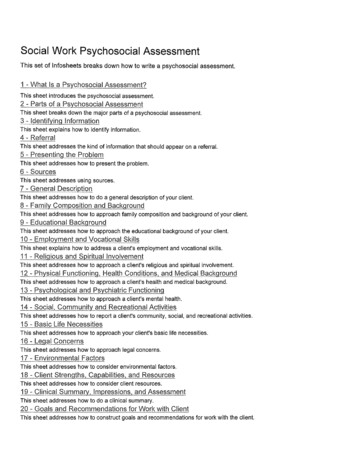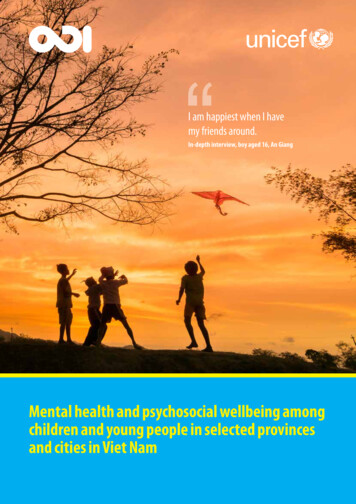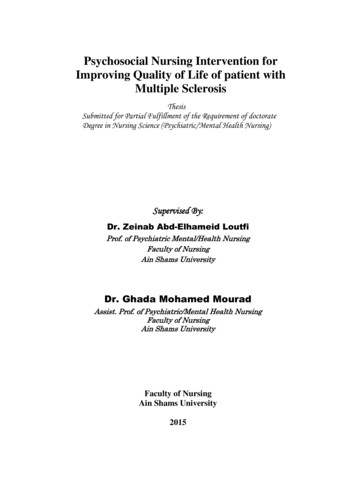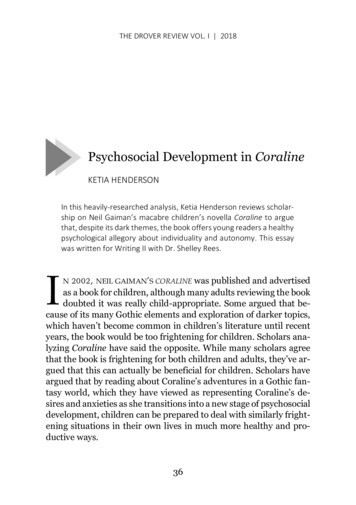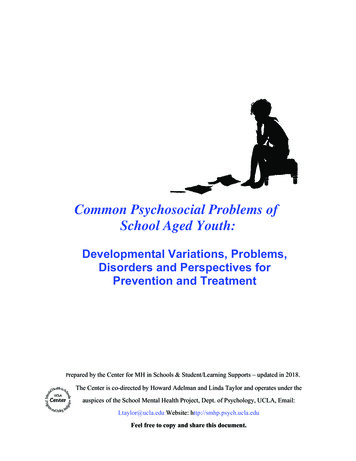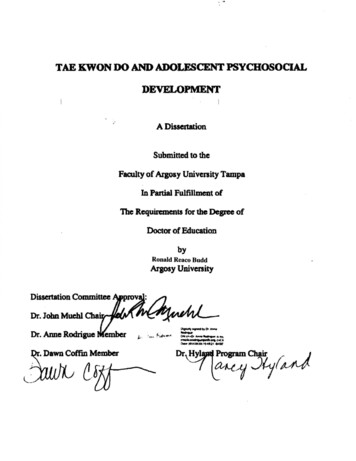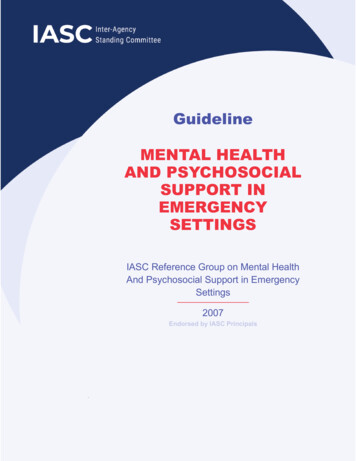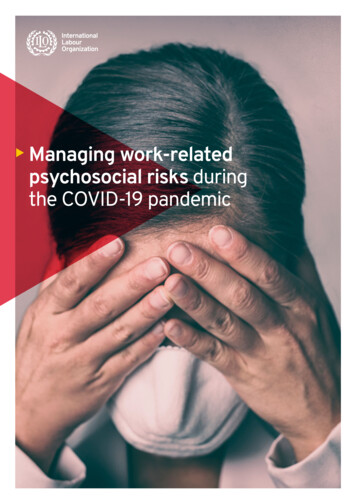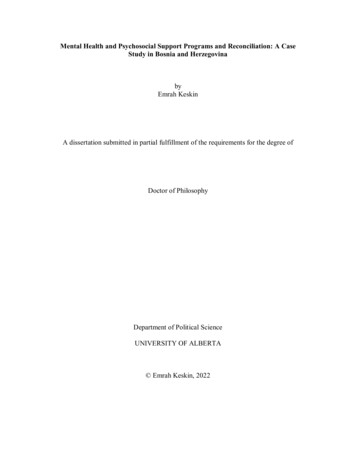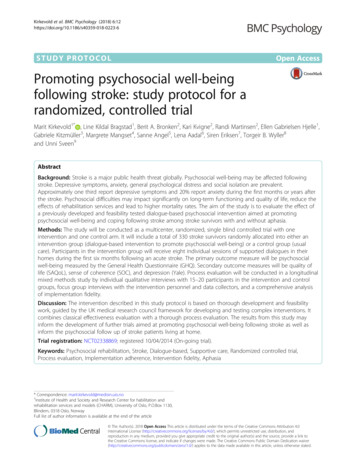
Transcription
Kirkevold et al. BMC Psychology (2018) 6:12https://doi.org/10.1186/s40359-018-0223-6STUDY PROTOCOLOpen AccessPromoting psychosocial well-beingfollowing stroke: study protocol for arandomized, controlled trialMarit Kirkevold1* , Line Kildal Bragstad1, Berit A. Bronken2, Kari Kvigne2, Randi Martinsen2, Ellen Gabrielsen Hjelle1,Gabriele Kitzmüller3, Margrete Mangset4, Sanne Angel5, Lena Aadal6, Siren Eriksen7, Torgeir B. Wyller8and Unni Sveen9AbstractBackground: Stroke is a major public health threat globally. Psychosocial well-being may be affected followingstroke. Depressive symptoms, anxiety, general psychological distress and social isolation are prevalent.Approximately one third report depressive symptoms and 20% report anxiety during the first months or years afterthe stroke. Psychosocial difficulties may impact significantly on long-term functioning and quality of life, reduce theeffects of rehabilitation services and lead to higher mortality rates. The aim of the study is to evaluate the effect ofa previously developed and feasibility tested dialogue-based psychosocial intervention aimed at promotingpsychosocial well-being and coping following stroke among stroke survivors with and without aphasia.Methods: The study will be conducted as a multicenter, randomized, single blind controlled trial with oneintervention and one control arm. It will include a total of 330 stroke survivors randomly allocated into either anintervention group (dialogue-based intervention to promote psychosocial well-being) or a control group (usualcare). Participants in the intervention group will receive eight individual sessions of supported dialogues in theirhomes during the first six months following an acute stroke. The primary outcome measure will be psychosocialwell-being measured by the General Health Questionnaire (GHQ). Secondary outcome measures will be quality oflife (SAQoL), sense of coherence (SOC), and depression (Yale). Process evaluation will be conducted in a longitudinalmixed methods study by individual qualitative interviews with 15–20 participants in the intervention and controlgroups, focus group interviews with the intervention personnel and data collectors, and a comprehensive analysisof implementation fidelity.Discussion: The intervention described in this study protocol is based on thorough development and feasibilitywork, guided by the UK medical research council framework for developing and testing complex interventions. Itcombines classical effectiveness evaluation with a thorough process evaluation. The results from this study mayinform the development of further trials aimed at promoting psychosocial well-being following stroke as well asinform the psychosocial follow up of stroke patients living at home.Trial registration: NCT02338869; registered 10/04/2014 (On-going trial).Keywords: Psychosocial rehabilitation, Stroke, Dialogue-based, Supportive care, Randomized controlled trial,Process evaluation, Implementation adherence, Intervention fidelity, Aphasia* Correspondence: marit.kirkevold@medisin.uio.no1Institute of Health and Society and Research Center for habilitation andrehabilitation services and models (CHARM), University of Oslo, P.O.Box 1130,Blindern, 0318 Oslo, NorwayFull list of author information is available at the end of the article The Author(s). 2018 Open Access This article is distributed under the terms of the Creative Commons Attribution 4.0International License (http://creativecommons.org/licenses/by/4.0/), which permits unrestricted use, distribution, andreproduction in any medium, provided you give appropriate credit to the original author(s) and the source, provide a link tothe Creative Commons license, and indicate if changes were made. The Creative Commons Public Domain Dedication o/1.0/) applies to the data made available in this article, unless otherwise stated.
Kirkevold et al. BMC Psychology (2018) 6:12BackgroundStroke is a major global health problem [1]. Psychosocialwell-being is frequently threatened following stroke.Depressive symptoms, anxiety, general psychological distress and social isolation are prevalent [2]. Approximatelyone third report depressive symptoms and 20% reportanxiety during the first months and depression may bepresent years after the stroke [3–5]. Psychosocial difficulties may impact significantly on long-term functioningand quality of life [4, 6], reduce the effects of rehabilitationservices and lead to higher mortality rates [7].A large number of studies have explored possible interventions to prevent and/or treat psychosocial problems[7–10], but results have generally been disappointing.Pharmacological treatment may be effective in treatingpost-stroke depression, but not in preventing it. Furthermore, antidepressants may have adverse effects in personswith stroke and should be used with care [7, 11]. Consequently, there is a need for developing alternative interventions. So far, psychosocial interventions have hadmodest effects; however, the findings conclude that information, emotional support, practical advice and motivational support are important [8, 10, 12, 13]. It remainsunclear how the different elements of the interventionscontribute to positive outcomes and which elementswork best at different stages and among different subgroups [8, 10, 12]. Few studies have provided adequatetheoretical accounts of the mechanisms assumed tocontribute to positive outcomes [8, 10, 12].Aphasia affects about one third of the stroke population [14] and 40% continues to have significant language impairment at 18 months post-stroke [15].Language is the most important tool for human interplay, social participation and community. Aphasia is associated with major disruptions of everyday life andaffects all dimensions of quality of life [16, 17]. Personswith aphasia (PWA) are especially prone to psychosocial problems, such as anxiety and depression, threatened identity, changes in interpersonal relationships,reduced social networks, social isolation, unemployment and abandonment of leisure activities [18–23].The emotional and psychosocial factors have a markedimpact on recovery, the psychosocial adjustmentprocess, and the response to rehabilitation [24, 25].Nevertheless, psychosocial interventions targeting thisgroup are sparse and access to such services verylimited.The incidence of stroke increases dramatically with increasing age [1]. However, stroke may appear at any age.Among younger work-aged stroke survivors (aged 18–67 years), the psychosocial factors appear to have at leastas great an impact on life after stroke as the physiological consequences [26–28]. Despite the potential serious consequences among younger persons, fewPage 2 of 12intervention studies have sought to develop psychosocialinterventions tailored to their specific needs.Registered nurses (RNs) are among the members inthe rehabilitation team who are expected to address thepsychosocial needs of patients through providingsupport and guidance to improve coping [29, 30]. Nevertheless, only a few nursing interventions have beendeveloped, specifically addressing the psychosocial wellbeing of stroke survivors [31–34]. These are promising,but have mostly been conducted by hospital-based staff.However, a major thrust of the rehabilitation occurs inthe community. Consequently, effective interventions forprimary health care are needed. Nurses are the most numerous professionals within this sector and are frequently the front line workers providing care to strokesurvivors. Other health care professionals as well, including occupational therapists (OTs), are responsiblefor promoting coping and adjustment to the consequences of stroke [35, 36]. However, few interventionsdelivered by primary health care professionals have beendeveloped and tested.To address this void, we have developed and initiallytested a dialogue-based psychosocial intervention primarily carried out in primary care, aimed at supportingthe coping and life skills of stroke survivors [37]. In thiswork, we applied a development and testing approachconsistent with the recommended framework for developing and evaluating complex interventions proposed bythe UK Medical Research Council [38, 39]. This framework describes the development and testing of complexhealth interventions in four interacting phases, from theinitial development phase, through the ‘modeling’ and‘exploratory trial’ phases into the ‘RCT’ phase and finallythe ‘long-term implementation’ phase. In our previousstudies, we have completed the first three phases. In thefirst two phases, we reviewed relevant research and theory to develop an empirical- and theory-based intervention [37]. In the exploratory trial phase, we used amultiple case study approach, drawing on different datasources to explore if the intervention was found usefulby twenty five stroke patients [40].The participants in the exploratory trial/feasibilitystudy found the content and process of the interventionrelevant. The participants underscored the benefits ofbeing supported through a difficult time, provided achance to tell and (re)create their story and being supported in their attempts to cope with the situation.Receiving psychological support and motivation to moveon during the difficult adjustment process, and exchangeof knowledge and information were also experienced asbeneficial and important by the participants [41–44].The aphasia group emphasized the importance and experienced benefit of receiving language support throughthe opportunities to speak and being supported in
Kirkevold et al. BMC Psychology (2018) 6:12communicating about their experiences by aknowledgeable dialogue partner [41, 42]. The studyprovided initial support for the usefulness of the psychosocial intervention and suggested aspects thatneeded further consideration and development. In particular, the intervention should be further developed forpersons with aphasia. In addition, the younger participants (i.e. people in working-age) emphasized the needfor a psychosocial program that specifically addressedtheir particular challenges and needs as carers for children, breadwinners in their families and as employeesstruggling to return to work [43]. Based on these findings, testing in a larger, controlled trial is warranted.In the current study, we use the same content, structureand process that were tested in the initial exploratorytrial/feasibility study. However, based on the findings fromthe preliminary work, we have adjusted the interventionto accommodate the weaknesses and challenges uncovered in the exploratory trial/feasibility study.Page 3 of 123. How the data collectors experienced the datacollection interviews with the participants, includingthe acceptability and/or difficulties in applying theinstruments in this population4. Implementation fidelity and intervention adherencethroughout the studyMethodsDesignThe study is a prospective multicenter randomized controlled trial to evaluate the effectiveness of a dialoguebased longitudinal intervention study the first sixmonths following a cerebrovascular stroke for personswith and without aphasia. The trial has one interventionand one control arm. The process evaluation is a longitudinal mixed-methods study. The protocol is preparedaccording to the Standard Protocol Items: Recommendations for Interventional Trials (SPIRIT).SettingAims and hypothesesThe primary aim of the study is to determine whether apreviously developed and feasibility-tested dialoguebased psychosocial intervention promotes psychosocialwell-being and coping following stroke among strokesurvivors with and without aphasia, compared to usualcare. We will test the following hypotheses:1. Primary outcome: Stroke survivors with and withoutaphasia in the intervention group will experiencesignificantly higher levels of psychosocial well-beingand lower levels of depressive symptoms and anxiety(measured by GHQ-28) than stroke survivors in thecontrol group at 6 and 12 months post stroke2. Secondary outcomes: Stroke survivors with and withoutaphasia in the intervention group will experiencesignificantly higher levels of sense of coherence(measured by SOC-13) and health-related quality of life(measured by SAQOL-39) than stroke survivors in thecontrol group at 6 and 12 months post strokeThe secondary aim of this study is to conduct a processevaluation in order to understand the change mechanismsof the intervention and how these impact on the participants’ study outcomes. To improve our ability to interpretthe study outcomes, the process evaluation will assess:1. How participants in the intervention and controlgroup experience their adjustment process followingthe stroke and their participation in the study2. How the personnel delivering the interventionexperiences their role in the intervention deliveryand the participants’ responsiveness to theinterventionThe study is primarily conducted in community care settings in Norway. The intervention is mainly delivered inthe homes of the participants. However, in the initialphases, the dialogue-based sessions may be conducted inother settings if necessary, such as in a hospital, at a rehabilitation unit or another place where the participantsfind themselves. The intervention is delivered by specially trained nurses and occupational therapists.ParticipantsInclusion and exclusion criteriaThis RCT study includes stroke survivors meeting thefollowing inclusion criteria: Being adults over 18 years ofage, suffered an acute stroke within the last month priorto inclusion, medically stable, sufficient cognitive functioning to participate (assessed by their physician/stroketeam), interested in participating, able to understand andspeak Norwegian, and able to give informed consent.Exclusion criteria include moderate to severe dementia, serious somatic or psychiatric disease as these are assumed to impact on the ability to participate in theintervention. All participants are screened for aphasiausing the Ullevaal Aphasia Screening Test (UAS) [41],and a speech therapist will be consulted if needed. Persons will be excluded if they have significant impressiveaphasia or severe expressive aphasia, but will otherwisebe included.Sample size calculationsThe study’s sample size was calculated based on the primary outcome measure GHQ-28, which has been usedin a comparable trial [31, 32]. Following Watkins et al.’sresults, we deemed an odds ratio of 1.6 or higherbetween-groups (intervention/control) with normal
Kirkevold et al. BMC Psychology (2018) 6:12mood after 6 and 12 months to be clinically relevant.The calculations are based on a repeated measures logistic regression model for the output variable “normalmood” (GHQ-28 5) with two measurements for eachpatient (i.e. one at 6 months and one at 12 months),with one binary input variable specifying group allocation. Based on 80% power across both time points, thecalculated sample size of this study is 300 participants,150 in each arm of the study. To allow for a 10% dropout rate, we have inflated the number to 330 participantsin total.Study proceduresRecruitment and consentParticipants are recruited from 11 acute stroke units orrehabilitation units in university hospitals and otherlocal hospitals providing acute care in Norway. Participants are identified by specifically trained clinical staff inthe participating units, based on the stated inclusion andexclusion criteria following the recruitment protocol ofthe study. Recruitment occurs when the patient is medically stable and considered ready for receiving information about the study. Eligible patients, who have sufferedan acute stroke within the last four weeks, will receiveoral and written information and be invited to enter thestudy. Potential participants who are not ready to decidewhether they will participate or not at this early stage,will be given information and asked if they can be contacted at a later stage. The written information sheetand consent form have been developed to accommodateaphasia and have been approved by the Regional MedicalEthics committee and the Data Protection Officer at theparticipating hospitals. Recruitment will occur over athree-year period.Randomization and blindingA computer-generated block randomization procedurecreated by a statistician independent of the researchgroup is applied. The participants are randomized inblocks of 10 to minimize allocation bias, and to ensurean equal group size in intervention and control groups.The randomization is stratified by study center. Opaquerandomization envelopes with a five-digit patient identification number printed outside and a note specifyingintervention or control inside, are prepared according tothe computer-generated randomization lists by an assistant independent of the research group. Two regionalstudy coordinators carry out the randomization processfollowing a completed baseline assessment. To ensureblinding of the assessors, group allocation is communicated solely to the patient him or herself and the healthcare professional delivering the intervention when thepatient is randomized to the intervention group. Tomaintain blinding at follow up assessments, a textPage 4 of 12message is sent from the study coordinator to each participant prior to each assessment reminding them not toreveal their group allocation to the assessor.The intervention: Promoting psychosocial well-beingfollowing strokeTheoretical perspectives underpinning the interventionThe overall goal of the intervention is to promote psychosocical well-being, defined as: (a) a basic mood ofcontentment, pleasure and well-being and the absenceof sadness or a feeling of emptiness, (b) participationand engagement in meaningful activities beyond oneself,(c) good social relations and a feeling of loving and beingloved in mutual relation(s), and (d) a self-concept characterized by self-esteem, self-acceptance, usefulness andbelief in one’s own abilities [42]. Each of these dimensions will be addressed in the dialogues.Experiences of chaos and a lack of control are majorthreats to well-being following stroke. Antonovsky’s theoryconnects health and well-being to the experience of a senseof coherence in life (SOC). SOC is promoted by experiencing life events as comprehensible (cognitive), manageable(instrumental/behavioural) and meaningful (motivational)[43, 45, 46]. SOC is seen as an essential intermediate goalfor promoting psychosocial well-being [37].To promote SOC, we draw on narrative theory [47, 48],which emphasises that human beings create meaning intheir lives through the stories they tell. Through stories,people seek to negotiate a position within a given socialcontext that gives meaning, direction, identity and valueto their lives [49, 50]. Research suggests that telling one’sstory is a fundamental need following a traumatic eventand that this may promote well-being in and of itself[51, 52]. We assume that being encouraged and supported to tell one’s story, receiving response fromothers and experiencing that stories are shared wouldstimulate reflection and adjustment and strengthenidentity, self-understanding and self-esteem.People suffering from aphasia are restricted in theirnatural abilities to tell their stories [53, 54]. The method“Supported Conversation for Adults with Aphasia”assigns a particular responsibility for facilitating socialinteractions to the person without communication difficulties and provides a number of different techniquesthat may enhance communication and understanding indialogues with PWA [55].To promote coping and development of new life skills,we apply ideas from guided self-determination [56], anapproach inspired by empowerment philosophy. It highlights the importance of being in control of one’s ownrecovery- and adjustment process. In this approach, therole of the health care professional is conceptualized asbeing a “supporter” or “coach” rather than a “carer” or“therapist”. The participants are in charge of the
Kirkevold et al. BMC Psychology (2018) 6:12dialogues in the sense that they decide what to focus onin each encounter, whereas the health care professionalfollows the participants’ lead. At the same time, thestructure of the intervention, with the guiding topicaloutline of each encounter and supporting work sheets,provide a framework for the dialogues that the participant and health care professional may follow or deviatefrom [37].The interventionThe intervention consists of 8 one to one and a halfhour dialogue-based sessions between the stroke survivor and a specially trained health professional (RN orOT). Each meeting has a guiding topical outline, whichaddresses significant issues described in the research literature (e.g. bodily changes, emotional challenges, personal relations, daily life issues, meaningful activities,existential issues, important values etc.) (Fig. 1).In the sessions, work sheets developed to support thedialogues are used. The work sheets consist of drawings,figures, unfinished sentences, and key words that pointto the topic that the participants are invited to address.The work sheets are adapted to persons with aphasia.The sessions are in part carried out as open dialogues,where the participants are invited to tell about issuesthat are important to them at the time, and in partstructured by the work sheets developed for the particular meeting. If the participant initially introduces a topicthat is different from the topic suggested for the particular session, the health care professional changes theplanned order of topics, i.e. by using work sheets fromother planned sessions. In this way, the intervention ismade flexible to meet the individual participant’s needs.The first session occurs approximately between 4 and8 weeks post stroke, the last is conducted before the6 months post-stroke time point (Fig. 1). The intervention is offered to the participants during the periodwhen the recovery- and adjustment process is assumedto be most challenging. The sessions take place at timesof increased vulnerability due to known transition points(i.e. at discharge, when physical improvement slowsdown, when people tend to assume new challengingroles or activities etc.). The number of sessions (8) ischosen in an attempt to balance the ideal with the realistic (i.e. as few encounters as possible but enough toprovide adequate support).Control groupThe control group receives treatment as usual and nointervention beyond participation in the assessment interviews at 1, 6, and 12 months. As participants are recruited from a variety of settings (acute stroke care andrehabilitation units), we anticipate some variation in theusual care provided. Provision of rehabilitation servicesPage 5 of 12is the responsibility of the community health care servicesin Norway, and this adds to the anticipated variability inservices. Systematic psychosocial rehabilitation and support is not implemented in community health care services in Norway. However, adoption of the National stroketreatment guidelines in the acute phase of stroke (basedon international stroke treatment guidelines) is high inNorway. To control for the potential variability in “usualcare”, we collect data on the types of rehabilitationservices received in both arms of the study.Outcome measurementsThe primary outcome is psychosocial well-being as measured by The General Health Questionnaire (GHQ-28).The GHQ was developed by Goldberg [57] and has beentranslated into Norwegian by Malt and colleagues [58].The GHQ-28 has been used in other trials involving psychosocial stroke interventions [31, 32, 59] and was alsoused in Hilari et al.’s study of SAQOL-39 [44], which willfacilitate comparison.The Stroke Aphasia Quality of Life scale (SAQOL-39)addresses general dimensions of health-related quality oflife (HRQOL). It is based on the Stroke-specific Qualityof Life scale (SS-QOL) and was adjusted for personswith aphasia. It has been found to be valid and reliablein the general stroke population and to be sensitive tochange [44, 60]. SAQOL 39 was tested in the exploratorytrial for appropriateness and was found to functionadequately.Sense of Coherence (SOC-13), has been translated intoNorwegian and previously been applied in studies focusing on psychosocial well-being [61–64].NIHSS is a well-established assessment for measuringstroke severity used in numerous stroke studies [65].Yale is a one item instrument measuring the presenceor absence of depression as experienced by the person.It has been validated as a measurement for depression instroke patients [66, 67].Lee Fatigue Severity Scale (5 items) and FatigueQuestionnaire (2 items) have been chosen to measurefatigue in this study [68, 69].The Ullevaal Aphasia Screening test (UAS) is a quickand simple aphasia screening which can be used byhealth professionals other than speech therapists to discriminate between aphasia and normal language. It hasbeen shown to be reliable in several studies [41, 70].The instruments and related constructs are summarized in Table 1.All instruments will be administered at T1 (at 1 monthpost-stroke and before randomization and potential initiation of the intervention), at T2 (6 months after stroke,approximately two weeks after the end of the intervention), and at T3 (12 months after stroke / 6 months afterthe end of the intervention). The instruments will be
Kirkevold et al. BMC Psychology (2018) 6:12Page 6 of 12Fig. 1 Flowchart of intervention with main content in each sessionadministered by data collectors with a health care background (RN and OT) using a personal interview format.The assessor is blinded to group allocation at each datacollection point. At T0 (at hospital / rehabilitation unit)medical information about the stroke and stroke severity(NIHSS-score) will be collected. Data and all appropriatedocumentation will be stored for a minimum of 5 yearsafter the completion of the trial, including the follow-upperiod. The Standard Protocol Items: Recommendationsfor Interventional Trials (SPIRIT) Flow diagram showingthe schedule for enrolment, interventions and assessments is provided in Table 2.Statistical analysisData analysis will be conducted as intention-to-treat.Missing data will be imputed using multiple imputationtechnique [71]. All analyses will be performed using statistical software such as IBM SPSS or R. For group comparisons of individual variables, categorical variables willbe analyzed using chi-squared tests, and continuous
Kirkevold et al. BMC Psychology (2018) 6:12Page 7 of 12Table 1 Overview of instruments and related constructsConstructInstrumentDomainsPsychosocial well-beingThe General HealthQuestionnaire-28 (GHQ-28)28 item general scale measuring emotional distress. Four subscales(somatic symptoms, anxiety/insomnia, social dysfunction and serious depressionPsychosocial well-beingThe Stroke and Aphasia Qualityof Life scale (SAQOL-39)Disease-specific quality of life scale, measures patient’s perspective of stroke’simpact on ‘physical’, ‘psychosocial’ and ‘communication’ domains.Sense of coherenceSense of Coherencescale (SOC-13)Self-report questionnaire, 13 components, measuring the main concepts inthe SOC theory; coherence, meaningfulness and manageability. 13 items scoredon a Likert scale, ranging from 1 to 7. Higher scores indicate a stronger SOC.Depression and anxietyThe Yale Brown singleitem questionnaire (Yale)One yes/ no questionFatigueLee’s Fatigue scale-5 (Lee-5)A 0–10 scale assessing symptoms of fatigueFatigueFatigue Questionnaire-2 (FQ-2)One yes/ no question, If yes; length of symptoms.DemographicsAge, gender, ethnic background, education, type of work/studies, marital status,living condition, family/network, place of living (urban/rural)Medical informationTime of stroke, type / localization of stroke, type of medical treatment after stroke,medication, other chronic diseases, earlier depression / mental disorders,rehabilitation services provided, type and amount of health care/practiceassistance provided in the community.Stroke severityNational Institutes ofHealth Stroke Scale (NIHSS)A questionnaire used by healthcare providers to objectively quantify theimpairment caused by a stroke.AphasiaThe Ullevaal AphasiaScreening Test (UAS)Screening for aphasia.variables will be analyzed using t-tests or Mann-WhitneyU tests (for two-group comparisons) and F-tests orKruskal-Wallis tests (for more than 2 groups). The primary statistical analysis will be a repeated measures logistic regression model for the dichotomized outputvariable “normal mood yes/no” (GHQ-28 5 versusGHQ-28 5) with two measurements for each patient(i.e. one at 6 months and one at 12 months), with onebinary input variable specifying group allocation. Independent variables will include demographic variables,stroke type and severity measurements, rehabilitationservice use and relevant medical variables. Medical anddemographic variables will be included in the data analysis model to control for group differences at baseline.Secondary analyses, e.g. sub-group analyses, will be conducted with primary, secondary and process outcomes.The psychometric properties of GHQ-28 will be examined to confirm stability of dimensions in a Norwegiangeneral stroke population across time points. All statistical tests will be performed as two-sided tests with asignificance level of 0.05.Program assessment and treatment fidelity/processevaluationTraining and supervisionTo promote high fidelity in intervention delivery, a 3day training course has been developed to ensure intervention delivery according to protocol. The 3-day courseis designed as an interactive training consisting of arange of lectures combined with practical training exercises, group reflection and discussions, and individualreading assignments. The training will give an in-depthintroduction in guided self-determination, supportedconversations for adults with aphasia, and cover all thetheoretical und
Stroke is a major global health problem [1]. Psychosocial well-being is frequently threatened following stroke. Depressive symptoms, anxiety, general psychological dis-tress and social isolation are prevalent [2]. Approximately one third report depressive symptoms and 20% report anxiety during the first months and depression may be
